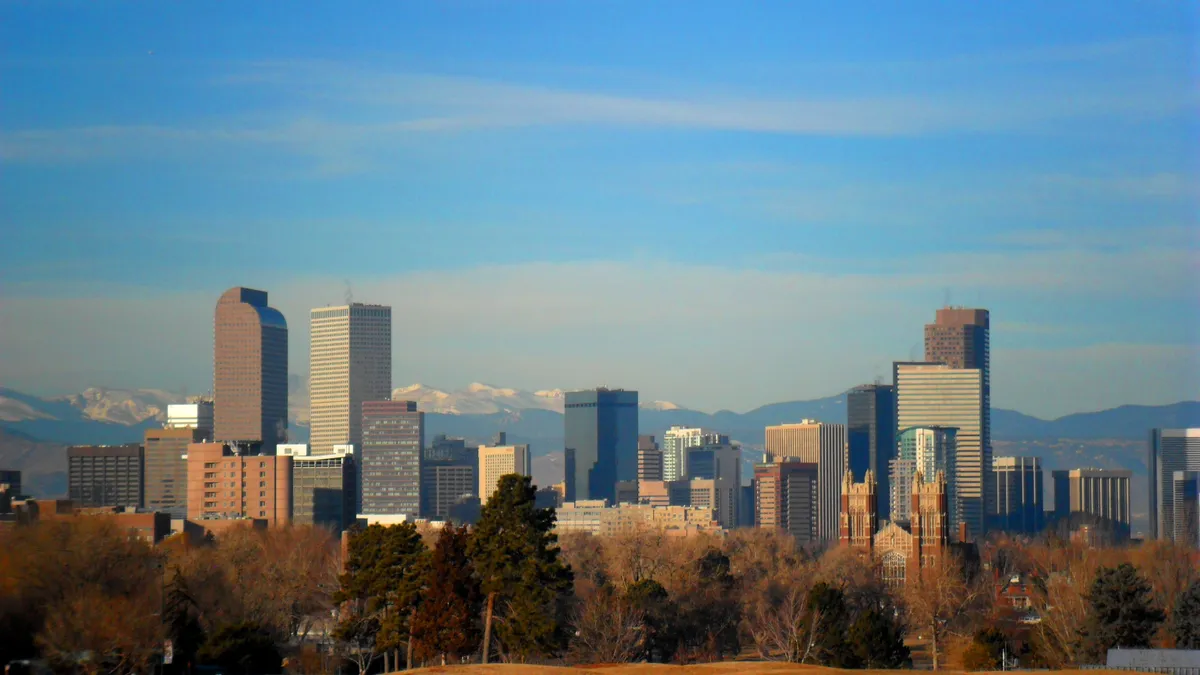Colorado policy-makers have outlined some ambitious climate goals, but new research indicates the state isn't on track to meet them.
The state faces different challenges in achieving a high penetration of renewables, experts said at the Solar Power and Energy Storage Mountain West conference in Denver last month, including the need for new transmission build-out and market structures. State regulators, meanwhile, are eyeing an expansion of utility distribution system planning processes, which also has a role to play in Colorado’s transition.
Democratic Colorado Gov. Jared Polis last year signed legislation that put the state on the path to achieve economy-wide emissions reductions of 26% by 2025, 50% by 2030 and 90% by 2050, as compared to 2005 levels. Polis also issued his own roadmap, outlining Colorado's path to 100% renewable electricity by 2040.
But analysis commissioned by Environmental Defense Fund (EDF) as well as Western Resource Advocates (WRA) found that current and planned policies would put the state 30 million metric tons above target in 2025, and 46 million metric tons above by 2030. Meeting the emission targets requires "significant and swift reductions throughout the economy, including power plants, transportation, oil and gas, commercial, and industrial sectors," the groups said in a press release.
Some of those reductions will be easier to achieve than others. The Colorado Energy Office feels pretty comfortable that the state is heading in the right direction regarding the electricity generation space, Executive Director Will Toor told Utility Dive at the February conference. The economics of renewables are currently well-aligned with utility needs and recent bid prices for utility-scale projects have been low enough to easily out-compete coal generation, he said, meaning that utilities in the state can move toward pretty deep decarbonization, largely through the closure of uneconomic coal plants.
"Where I think the bigger challenge is to meeting our emission targets lies really once we get beyond the electricity sector. Our second largest source of emissions is transportation and unlike [the electric sector], transportation emissions really aren't headed in the right direction," he said, adding that building emissions will also be a key issue.
Colorado's goals align roughly with emissions reductions that would be required to limit warming across the globe to 1.5 degrees Celsius above pre-industrial levels, and is also in line with states like New Mexico and Nevada, both of which are aiming to reduce emissions 45% by 2030. By 2025 and 2030, Colorado will need to reduce its economy-wide emissions by 32 million and 62 million metric tons respectively. However, the analysis from EDF and WRA found that current policies will lead to reductions of 2 million and 16 million metric tons, leaving the state with a significant gap.
The report also listed various measures the state could take to bridge that gap by 2030. Retiring all existing coal-fired plants and replacing them with zero-emission resources would put in-state electricity generation emissions at 80% below 2005 carbon emission levels, per the report.
DERs have a role to play
Distributed energy resources and non-wires alternatives will have a role to play in the state's efforts to reach its climate goals, according to Colorado Public Utilities Commission Chairman Jeffrey Ackermann. The Colorado PUC opened a docket last year to look into distribution system planning by the state's electric utilities.
"I think where we're at is realizing we need to find a way that balances public policy objectives of decarbonization and balances emerging market and consumer objectives…" he told Utility Dive.
Stakeholders will file a second round of comments in mid-March, after which "we'll see... how the docket evolves," Ackermann said, adding that the distribution system planning process could be expanded in several ways, creating transparency around how utilities make decisions and addressing the demands of resilience on the grid.
Amid all these changes, regulators should begin to have conversations around the data that utilities currently have "and maybe [hold] close to the vest," according to Ackermann. That data could help the commission and its staff have a better understanding of near-term issues and needs on the distribution grid.
Utilities are also going to face challenges as the state moves towards very deep renewables penetration, especially since Colorado is not currently in a regional energy market, Toor said. Utilities operating in the state are currently looking to either the California Independent System Operator or Southwest Power Pool, he said.
"There's just a whole set of challenging market and technological questions that you start facing once you start going from 80% to 100% [decarbonization], that I think are going to be very important to our utilities," he added.
'Market structures are critical'
In fact, transmission build-out and market structures are the primary barriers to high levels of renewables penetration in the west, according to multiple experts at the conference.
The western grid market structure is mostly set up to serve coal to California, Johnny Casana, senior manager of U.S. political and regulatory affairs at the Pattern Energy Group, said. But it isn't well-suited to sourcing weather dependent, variable resources to sparsely separated urban centers. It's very difficult to get access to customers in the west, he said, adding, "So market structures are critical to [get] access to customers, so that you can deploy the capital that you need to overcome siting challenges."
The west needs more transmission and needs to use it more efficiently, Orijit Ghoshal, senior manager of regulatory affairs at Invenergy, said. But the other side of customer access is also actually interacting with customers.
"And that's a unique challenge to the west because the rest of the country — even in places like parts of the mid-Atlantic and the Southeast — you do have your choice, [with] more access to RTOs and ISOs," he said.























